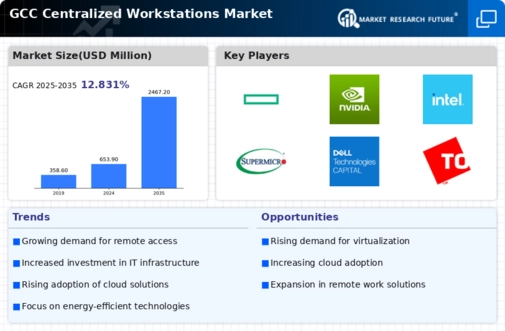Market Growth Projections
The Global GCC Centralized Workstations Market Industry is poised for substantial growth, with projections indicating a market size of 12.5 USD Billion in 2024 and an anticipated increase to 25 USD Billion by 2035. This growth trajectory suggests a compound annual growth rate of 6.5% from 2025 to 2035. Various factors contribute to this upward trend, including technological advancements, rising cybersecurity concerns, and the increasing demand for remote work solutions. The market's expansion reflects the evolving needs of organizations seeking efficient and secure workstation solutions in a rapidly changing business landscape.
Rising Cybersecurity Concerns
The Global GCC Centralized Workstations Market Industry is significantly influenced by rising cybersecurity concerns among organizations. As businesses increasingly rely on centralized workstations, the need for robust security measures becomes paramount. Cyber threats pose substantial risks to sensitive data and operational integrity, prompting organizations to invest in secure workstation solutions. This trend is driving the demand for centralized workstations equipped with advanced security features, such as encryption and multi-factor authentication. Consequently, the market is expected to grow, with projections indicating it could reach 25 USD Billion by 2035, as companies prioritize cybersecurity in their operational strategies.
Growing Focus on Cost Efficiency
Cost efficiency remains a critical driver in the Global GCC Centralized Workstations Market Industry. Organizations are continually seeking ways to optimize their operational expenditures, and centralized workstations offer a viable solution. By consolidating resources and streamlining processes, businesses can reduce hardware costs and maintenance expenses. This focus on cost efficiency is particularly relevant in competitive markets where profit margins are tight. As a result, the adoption of centralized workstations is likely to increase, contributing to the market's growth. The anticipated rise to 12.5 USD Billion in 2024 underscores the financial benefits associated with this trend.
Expansion of Cloud Computing Services
The expansion of cloud computing services is a significant factor propelling the Global GCC Centralized Workstations Market Industry. As organizations migrate to cloud-based solutions, the demand for centralized workstations that can seamlessly integrate with cloud infrastructure is on the rise. This shift enables businesses to access applications and data from anywhere, enhancing operational flexibility. The increasing reliance on cloud services is expected to drive market growth, with projections suggesting a compound annual growth rate of 6.5% from 2025 to 2035. The synergy between cloud computing and centralized workstations is likely to redefine workplace dynamics in the coming years.
Increasing Demand for Remote Work Solutions
The Global GCC Centralized Workstations Market Industry experiences a surge in demand for remote work solutions, driven by the need for flexibility and efficiency in work environments. Organizations are increasingly adopting centralized workstations to facilitate remote access to critical applications and data. This trend is evident as businesses recognize the potential for enhanced productivity and collaboration among geographically dispersed teams. The market is projected to reach 12.5 USD Billion in 2024, indicating a robust growth trajectory. As companies continue to invest in technology that supports remote work, the Global GCC Centralized Workstations Market Industry is likely to expand significantly.
Technological Advancements in Workstation Solutions
Technological advancements play a pivotal role in shaping the Global GCC Centralized Workstations Market Industry. Innovations in hardware and software are enhancing the capabilities of centralized workstations, making them more efficient and user-friendly. For instance, the integration of artificial intelligence and machine learning into workstation solutions allows for improved data processing and analytics. These advancements not only streamline operations but also reduce operational costs for businesses. As a result, the market is expected to witness a compound annual growth rate of 6.5% from 2025 to 2035, reflecting the growing reliance on advanced technologies in the workplace.






















Leave a Comment